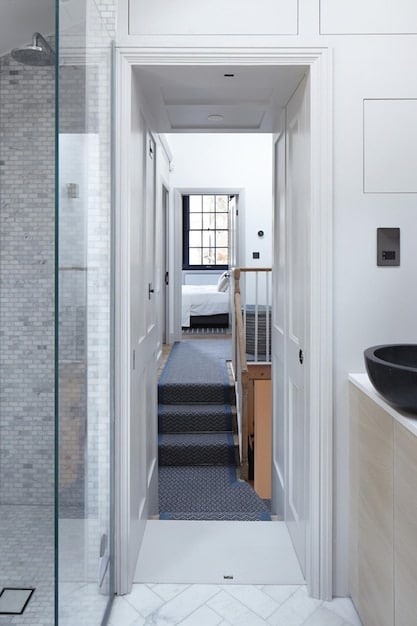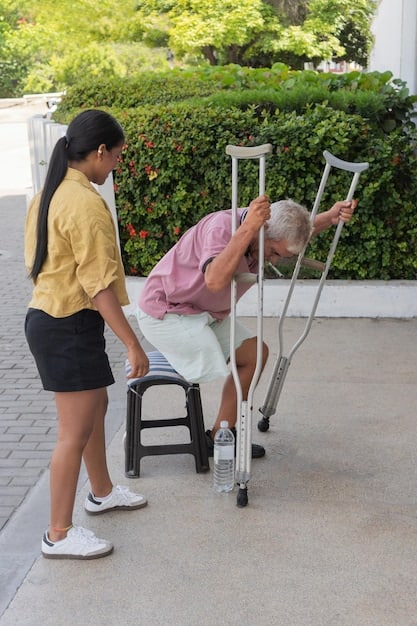Home Modification Grants: Your Guide to Accessible, Safe Homes in 2025

Home modification grants are financial resources designed to help make homes more accessible and safer for care recipients, enabling them to live more independently and comfortably in 2025 by covering costs for necessary renovations.
Making a home fully accessible and safe for a care recipient can feel like a daunting task, especially when considering the costs involved. Fortunately, home modification grants are available to help ease the financial burden and ensure your loved one can live comfortably and safely in their own home in 2025.
Understanding Home Modification Grants for 2025
Home modification grants provide funds for renovations that improve accessibility and safety for individuals requiring care. These grants can cover a wide range of modifications, from installing ramps to widening doorways, making bathrooms safer, and more. Understanding what these grants entail is the first step towards creating a more supportive home environment.
Types of Home Modifications Covered
The specific modifications covered by grants can vary depending on the funding source and the individual’s needs. However, common modifications often include:
- Ramps and Lifts: Providing access to the home for those with mobility challenges.
- Bathroom Modifications: Installing grab bars, walk-in showers, and raised toilets to prevent falls and improve safety.
- Kitchen Modifications: Adjusting counter heights and installing pull-down shelves for easier access.
- Doorway Widening: Making it easier for individuals using wheelchairs or walkers to navigate the home.
These modifications aim to reduce the risk of accidents and enhance the overall quality of life for care recipients.
Eligibility Criteria for Home Modification Grants
Eligibility criteria for home modification grants generally include factors such as:
- Income Level: Many grants have income restrictions to ensure resources are directed to those most in need.
- Disability or Medical Condition: The care recipient must have a documented disability or medical condition that necessitates home modifications.
- Residency: Applicants must reside in the home they wish to modify.
- Citizenship: Most grants require applicants to be legal residents or citizens of the United States.
Meeting these criteria is essential for accessing the financial assistance needed for home modifications.
Understanding the types of modifications covered and the eligibility criteria are critical for successfully applying for home modification grants, ensuring your loved one can remain safe and comfortable at home.
Navigating the Grant Application Process
Applying for home modification grants can seem complex, but understanding the process can help streamline your efforts. This involves researching available grants, preparing your application, and following up on your submission to increase your chances of success.
Researching Available Grants
Begin by researching federal, state, and local grants that offer funding for home modifications. Some key resources include:
- U.S. Department of Housing and Urban Development (HUD): Offers programs like the Community Development Block Grant (CDBG).
- State and Local Government Agencies: Check your state’s Department of Health and Human Services or local Area Agency on Aging.
- Nonprofit Organizations: Many nonprofits offer grants or assistance for home modifications.
Each grant has its own requirements and funding priorities, so it’s vital to find the ones that best fit your needs.
Preparing Your Application
A well-prepared application is essential for securing a home modification grant. This typically involves:
- Gathering Documentation: Collect medical records, proof of income, residency verification, and any other required documents.
- Obtaining Quotes: Get quotes from qualified contractors for the modifications you plan to make.
- Writing a Compelling Statement: Clearly explain the need for the modifications and how they will improve the care recipient’s quality of life.
Ensure all information is accurate and complete to avoid delays or rejection.

By thoroughly researching available grants and meticulously preparing your application, you can increase your chances of obtaining the necessary funding for home modifications.
Key Federal Grant Programs for Home Modifications
Several federal programs offer assistance with home modifications, each with its own specific focus and eligibility requirements. Understanding these programs can help you identify potential funding sources to support your home modification project.
The U.S. Department of Housing and Urban Development (HUD)
HUD offers various programs that can be utilized for home modifications, including:
- Community Development Block Grant (CDBG): Provides funding to local communities, which can be used for a variety of projects, including home modifications for low-income individuals.
- Section 202 Supportive Housing for the Elderly Program: Offers capital advances and operating subsidies to develop supportive housing for the elderly, which can include accessibility modifications.
These programs aim to improve housing conditions and accessibility for vulnerable populations.
Rural Housing Service (RHS)
The RHS, part of the U.S. Department of Agriculture, offers programs for rural homeowners, such as:
- Section 504 Home Repair Program: Provides loans and grants to low-income rural homeowners to repair, improve, or modernize their homes, including modifications for accessibility.
This program focuses on ensuring that rural residents have access to safe and accessible housing.
Navigating these federal programs requires careful research and preparation, but the potential benefits of securing funding for home modifications can be significant. By understanding the specifics of each program and tailoring your application accordingly, you can maximize your chances of receiving assistance.
State and Local Grant Opportunities
Beyond federal programs, many state and local governments offer grants and assistance for home modifications. These programs are often tailored to the specific needs and resources of the community, providing valuable support for care recipients and their families.
State-Specific Programs
Many states have their own programs dedicated to assisting individuals with disabilities and the elderly. These programs may include:
- Home and Community-Based Services (HCBS) Waivers: These waivers allow states to use Medicaid funds to provide services that enable individuals to remain in their homes rather than institutions. These services can include home modifications.
- State Housing Finance Agencies: These agencies often offer grants or low-interest loans for home improvements, including accessibility modifications.
Check with your state’s Department of Health and Human Services or Medicaid agency for more information on these programs.
Local Government Initiatives
Local governments, such as cities and counties, also play a role in providing home modification assistance. These initiatives may include:
- Community Development Block Grant (CDBG) Funds: As mentioned earlier, CDBG funds are often used for local home modification projects.
- Property Tax Relief Programs: Some local governments offer property tax relief to homeowners who make accessibility improvements.

By exploring state and local grant opportunities, you can tap into resources that are specifically designed to address the needs of your community. These programs often provide a more direct and targeted approach to funding home modifications, making it easier for care recipients to live safely and comfortably at home.
Nonprofit Organizations Offering Assistance
Nonprofit organizations are vital resources for individuals seeking home modification grants. These organizations often provide not only financial assistance but also guidance and support throughout the application process.
Habitat for Humanity
Habitat for Humanity offers various programs that focus on affordable housing and home repairs. Their programs may include:
- Critical Home Repair Program: Provides assistance to low-income homeowners to address critical health, safety, and accessibility issues.
Rebuilding Together
Rebuilding Together focuses on rehabilitating homes and communities. Their services include:
- Safe at Home Program: Provides modifications to make homes safer and more accessible for seniors and people with disabilities.
These organizations often work with volunteers and local contractors to complete home modification projects, helping to reduce costs and ensure quality workmanship.
Engaging with nonprofit organizations can provide access to a wealth of resources and support for home modification projects. These organizations are committed to improving the lives of vulnerable individuals by making their homes safer and more accessible, and they can be valuable partners in your efforts to secure funding and complete necessary modifications.
Planning and Prioritizing Home Modifications
Effective planning and prioritization are essential for successful home modifications. This involves assessing the care recipient’s needs, creating a detailed plan, and prioritizing the most important modifications to maximize safety and accessibility.
Assessing the Care Recipient’s Needs
Start by conducting a thorough assessment of the care recipient’s physical and cognitive abilities. Consider:
- Mobility: Can the individual walk independently, use a walker, or require a wheelchair?
- Vision and Hearing: Are there any visual or auditory impairments that need to be addressed?
- Cognitive Function: Are there any cognitive limitations that could impact safety?
Developing a Detailed Plan
Based on the assessment, create a detailed plan that outlines the specific modifications needed. This plan should include:
- Specific Modifications: List each modification, such as installing grab bars, widening doorways, or adding a ramp.
- Timeline: Create a timeline for completing the modifications, taking into account the availability of contractors and funding.
- Budget: Develop a budget that estimates the cost of each modification.
Prioritizing Modifications
Prioritize modifications based on their impact on safety and accessibility. Focus on:
- High-Risk Areas: Prioritize modifications in areas where falls or accidents are most likely to occur, such as bathrooms and kitchens.
- Essential Modifications: Focus on modifications that are essential for the care recipient to maintain independence and quality of life.
By carefully planning and prioritizing home modifications, you can ensure that the available resources are used effectively to create a safe and supportive home environment for the care recipient.
| Key Point | Brief Description |
|---|---|
| 🏠 Eligibility ✅ | Check income, disability, residency & citizenship requirements. |
| 💰 Grant Research 🔎 | Explore federal, state, and local grants for home modifications. |
| 📝 Application Prep ✍️ | Gather documents, get quotes, write a compelling statement. |
| 🛠️ Prioritize Needs 🎯 | Assess needs & prioritize based on safety and accessibility. |
Frequently Asked Questions
▼
Home modification grants are financial resources that assist in making homes safer and more accessible for individuals needing care. These grants cover renovation costs, enhancing independence and comfort.
▼
Eligibility criteria generally include income level, documented disability or medical condition, residency, and U.S. citizenship or legal residency.
▼
Common modifications covered include ramps, lifts, bathroom modifications (grab bars, walk-in showers), kitchen adjustments, and doorway widening.
▼
You can find grants through the U.S. Department of Housing and Urban Development (HUD), state and local government agencies, and nonprofit organizations.
▼
The application process involves researching available grants, gathering necessary documentation, obtaining quotes from contractors, and writing a compelling statement.
Conclusion
Navigating the world of home modification grants in 2025 can open doors to creating safer, more accessible homes for care recipients. By understanding the available resources, preparing thoroughly, and prioritizing needs, families can significantly improve the quality of life for their loved ones.





